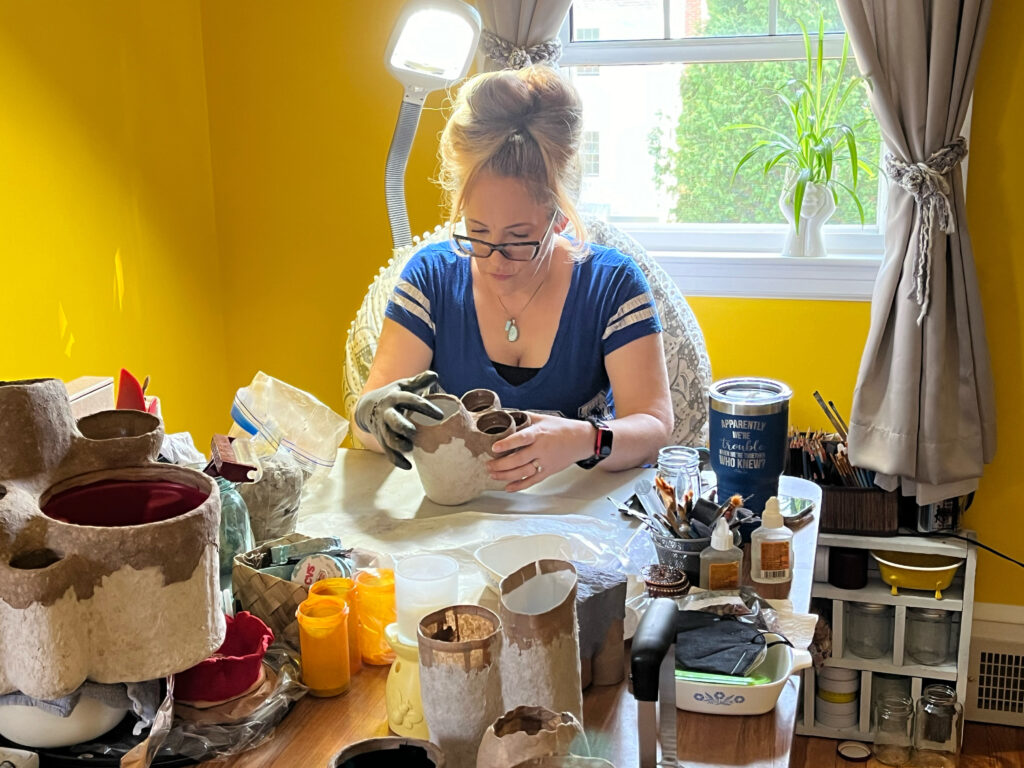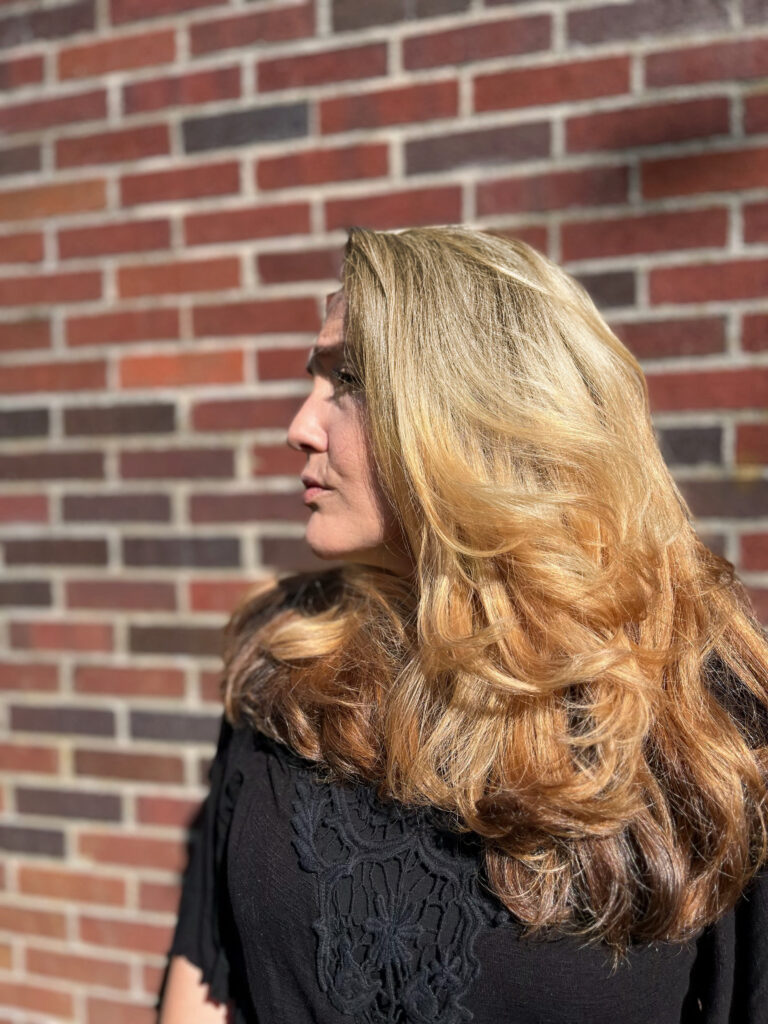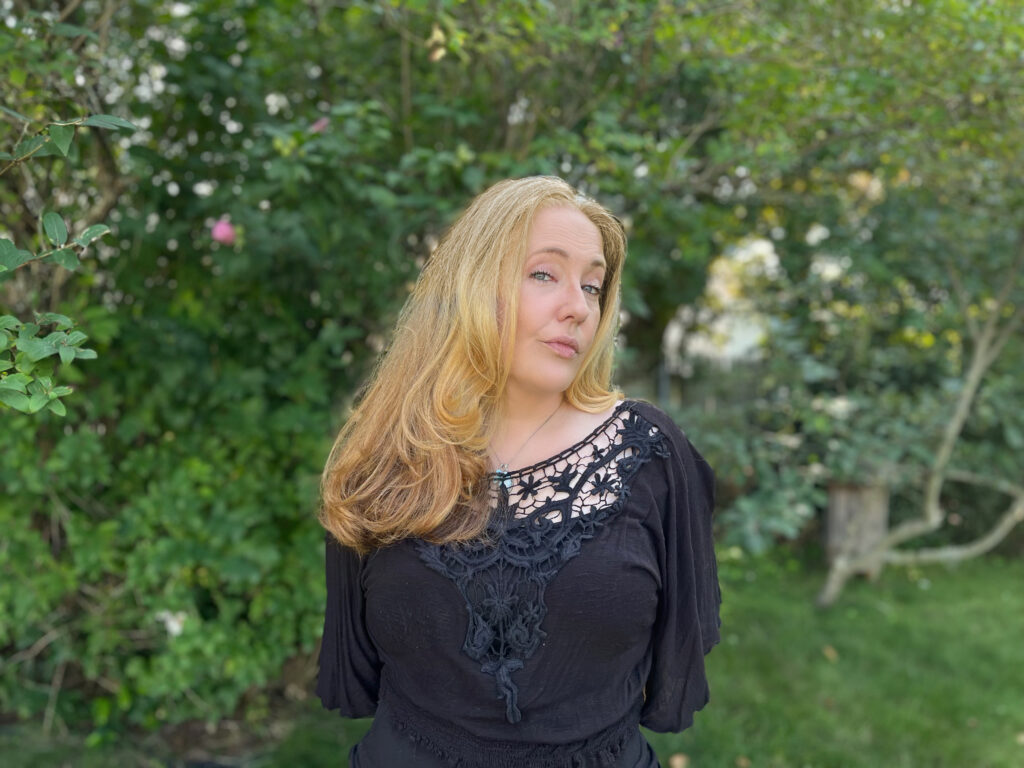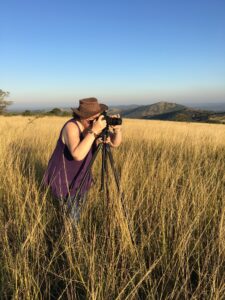In the world of art, there are moments when an artist’s true calling emerges, reshaping their creative journey and personal growth. For Jenna Corneau, that moment came while working on her series “Blithewold Blooms Under the Strawberry Moon.” It was here, amidst the interplay of clay and pigment, that Jenna discovered the profound connection between her soul and sculpting. Her story is one of transformation, as she navigates the delicate balance between control and surrender, all while battling chronic pain and mental health challenges. Through her innovative use of recycled materials and deep self-awareness, Jenna has crafted a unique artistic practice that not only breathes new life into discarded items but also fosters a deeper understanding of herself. Join us as we explore Jenna’s inspiring journey, where art and personal resilience intertwine to create something truly extraordinary.

Can you tell us about the moment you realized that sculpting was your calling?
I realized that sculpting was what really fed my soul when I was creating my second series “Blithewold Blooms Under the Strawberry Moon”. I started realizing that each batch of clay was needing to be worked differently. That, by the nature of the ingredients that I was putting together and how much pigment I was adding to the clay for the different elements, each smaller batch had its own properties as well. It became like a jigsaw puzzle and I realized that what my experience was before with my very first batch was not going to necessarily be my experience going forward. At first I started fighting the clay because I already had in my head what I wanted to do with it based on what I was able to do prior and what tools I was able to use (it doesn’t work like store bought earthen based clays). I quicky found out, after struggling for so long with my first piece in the series, that the clay was going to tell ME what it wanted to become. I’m a very stubborn person. It’s just part of my nature. I work hard to compromise in my relationships because it doesn’t necessarily come naturally for a stubborn person to do so. It takes hard work on a consistent basis.
My brain is always working, always trying to not let my depression, anxiety disorder, ADD symptoms and pain have a negative effects on my relationships and interactions each day. This was not a matter of compromising like I do with my loved ones. This had become about complete surrender. I realized I wouldn’t know until I started moving and working the clay what this batch was going to be capable of. I had to throw all of my diligent planning, that is constantly churning away in my head, into the ether and just let IT be in control. That’s not something I’m good at or typically enjoy. But there was something about this relationship with the clay that was teaching me and molding me at the same time. It was forming me as much as I was forming it! I’m not sure I have words for what that feels like for someone who’s comfort zone is being in control to suddenly and completely surrender it- for someone who’s brain just never stops planning and reflecting to have to completely stop- and to know that this is the flow that you have been missing for so long- for it to almost complete a part of me. Having that feeling was when I knew this was meant to be a part of not only my life and my time but my core self.

What inspired you to start PulptSculpt and focus on using recycled materials?
Pulptsculpt started out of necessity. The previous holiday season I had damaged my wrist pretty badly crocheting homemade gifts that I had created the patterns for (which had been my creative outlet up to that point and some of which the patterns for are still available on my Etsy store). With the economy being so tight and my only income having been my disability for the prior two decades, I had focused a portion of my gift giving on “from the heart”, handmade gifts. Being despondent over not being able to crochet without excruciating pain, I vowed to do something I have never been good at previously- stop crocheting and rest my body to let it heal. There are many trade offs and compromises people with chronic illness and pain conditions need to make to keep living as full of a life as possible while mitigating their symptoms and this was one that I hadn’t mastered yet.
My mental health started to steeply decline and without my hands and mind being busy, my pain moved more evidently to the forefront of my reality. I figured I would use some interesting scrapbooking paper I had sitting around taking up space and cover some plastic recyclables I had that would make a nice pot to replant some spider babies I had grown that needed a home. I figured if it worked out well then I would start making them for holiday gifts (yes, it was only the beginning of January- I’m a planner). My Capricorn brain tweaked that first, simple pot and tweaked it some more, coming up with new ideas each night as I lay trying to fight to sleep and each morning I would research and fine tune what my brain had dreamt up the night before until one day I tried out my ideas. The result ended up being my interior, sculptured clay pots made from 98 % materials I rescued from my recycling bin. All additional materials, like colorants and decorations (like my handmade dried flowers from our yard, gemstone chips, and clay binders) are 100% natural and non toxic. Reducing my household footprint has always been an important part of my life but since figuring out that I could not just recycle our waste but actually give it a second life for others to enjoy and that is can also be functional- combining my love of plants and my long forgotten passion for sculpting and adding in a healthy dash of upcycling just lit this special fire in me that I’ve always searched for! In the end, they became much more than simple paper mached gifts that they began their life as. I saw there was something really special about it all and my Etsy store ThePatternNerd turned into PulptSculpt!

How has your personal journey and your health challenges shaped your approach to sculpting?
I went decades without knowing what was wrong with my health. A lot of people with invisible illnesses, rare diseases or undiagnosed medical issues can tell you- sometimes it can feel like you’re going crazy. Until you find the right doctors and support system, it can be a very lonely fight that sometimes you feel like you’re not only fighting BY yourself but AGAINST yourself. Your body can feel like it’s betraying you. Once I started getting answers to those long sought questions and learned I had a collagen abnormality called Ehlers Danlos Syndrome (which comes with many other invisible, rare medical conditions joining the “party” like uninvited little hitchhikers), it was as if I started to become myself. When you realize, after decades, that there are other people like you out in the world, it’s like you’re covered in this thick, mucky honey junk that you can’t see thru and no one can see thru to you. The information you start getting, the pieces of yourself you start understanding and the people you start meeting start eating away at that honey and you can start experiencing life in a way you never really have before. I am thankful each and every day that I lived near many world renowned specialists in EDS here in Rhode Island and after years of learning from my Physical Therapist, Pain Management Specialist and Neurosurgeon what to do and not do (the “not do” list is WAY harder to be good about following  ) to avoid seriously messing myself up and ways to manage the symptoms when I ultimately mess myself up anyway, I have been able to translate those guidelines to work for my sculpting. I make sure to follow the rules as much as possible because I’ve learned from experience that I’ll be able to do and accomplish more things that are important to me in the long run if I take the time to be sure I’m doing them in a way that is going to minimize hurting myself. Specifically, I make sure I minimize how long I sit in “rule-breaking” positions. I still do it. My body still wants to.
) to avoid seriously messing myself up and ways to manage the symptoms when I ultimately mess myself up anyway, I have been able to translate those guidelines to work for my sculpting. I make sure to follow the rules as much as possible because I’ve learned from experience that I’ll be able to do and accomplish more things that are important to me in the long run if I take the time to be sure I’m doing them in a way that is going to minimize hurting myself. Specifically, I make sure I minimize how long I sit in “rule-breaking” positions. I still do it. My body still wants to.
But I try to catch myself as quickly as possible and rearrange myself. For example, I’ll catch myself with my legs all criss-crossed up on my chair seat and put my feet back on my sewing box (I’m short so I need something to keep my knees at a 90 degree angle). I have to pay attention to my neck position when I’m looking down so that my discs don’t slip out of position (yes, stretchy collagen affects SO many parts of the body) and frequently pull my work up to eye level to give my neck a break. I get up and move around and ice my spine hourly, usually taking a 20 minute ice break for every hour of work. I keep distractive noises on in the background for both my mental health and pain management. Currently Schitt’s Creek is an amazing compensation for raising my spirits with some good, LGBTQIA+ friendly laughs (I’ve lost count of how many times I’ve streamed the show at this point) and strangely the sound of people, even when only on my iPad, helps minimize any feelings of isolation when I’m in my studio alone. Having that focus while getting into the flow with the clay helps distract from any physical pain I am experiencing at any point as well. My studio is painted an extremely bright, vibrant yellow as well to bring my energy to the right place for creating. When I work on the other aspects of prepping for my sculpting, I do most of it in my “nest”- the chaise lounge part of our couch in the living room filled with pillows to keep my body in the correct alignment to minimize injury. I cover myself in old towels and go to work while spending quality time with my partner in the evenings. I keep supplies hidden around the house as close to where I use them yet out of sight when they are not in use to limit the amount of spoons wasted gathering them (Spoon Theory is a great thing to do a quick search on for anyone who has someone with a chronic illness in their life to understand how most of us have to live our life watching our “spoons”). Bottom line is, I do the physically hard stuff on the days I have extra spoons and I take frequent breaks. I work on the stuff I can accomplish in my “nest” on the days when spoons are low or pain is too much. I never know what kind of day the next day will be so I’ve also had to give up making plans too far out and just take each day for what it is. It’s sort of freeing in a strange way, and an be frustrating in others.
What emotions do you experience when you create a new piece, and how do they impact you?
I touched on this a little in one of my last responses but I’ll go a little deeper. Creating my pieces is physically exhausting and exhilarating at the same time. Limiting my time in the studio is hard but I try to keep a good work/life balance for my mental health and for the sake of my relationships. There are many steps before the actual sculpting can begin but when I am able to start a new series, I usually already have in mind what natural elements I would like to add to them for that seasons series. I like to choose elements that personify how each season feels to me. But there’s no telling if the clay is going to play nice with what I have in my head. Like I said before, I have to let go of most of my expectations, grab an armature that I’ve made up that feels right for the series and jump in.
The first part is building the stability of the armament since their only purpose is to give a waterproof surface inside the sculptures for the plants. As I start sculpting the bottom portions, I get to know the clay. How it moves, how sticky it is, what tools I can use with it or if I can only use my hands, what its limitations and advantages are. At this point I usually get into an almost meditative state where most thought is lost (I set timers before I begin for things like starting dinner- or they would never get done). For a person like me, to lose all thought was pretty unimaginable. I struggle to stop my brain from overthinking almost every minute of the day so there is a profound peace and serenity that occurs and it almost feels like my brain is getting a much needed rest and reset.
I have Dysautonomia so my nervous system typically gets caught in these stimuli loops of all different types that are nearly impossible to stop. Being able to turn off my brain in this process seems to stop the never ending loops, which gives an immense tranquility to my body. While I still have to watch any new stress I’m putting on it, the loop my head is typically in telling my central nervous system that my body is still in pain from something I did three days ago, ceases. I’m not sure I can adequately explain what a relief something like that is and how it not only affects the body but the mind and its mental health and sense of well-being. For someone in chronic pain it can become similar to a pain killer sans the nasty side effects. It has become natures little off switch happy pill for me. When I look at each finished piece I remember what creating it has done for me, even just temporarily, and continually feel gratitude to each and every one. Sending them to new homes is both gratifying and difficult because of the unique relationship I end up forming with each of them. From the feeling of almost communicating with the clay, listening to what it’s going to become, finding where its adornments belong, sealing it all into one sculpture and getting ready to send it off for someone new to use and love, it’s a very emotional journey which is unique to each and every sculpture. It’s something I’m thankful each day to be able to do and am grateful to every piece for what it has brought to my life.
Can you describe the process of making your sculptured pots from recycled materials?
Sure! As plastic containers are used in our daily life, I wash the ones that are strong enough to keep a barrier for the plants (if their new home decides to use them as pots). I typically only choose containers that have been food safe and avoid beauty and cleaning product containers as they tend to hold their smells and chemical residue. When the outdoor weather allows, I cut them into the height that will work best and remove any tapering tops.
Those are recycled. I thoroughly sand the parts that will be covered in paper. They are rinsed again and dried. They then go into waiting for a day when I am ready to apply a layer of heavy paper to them so the clay adheres well. They then wait again for when I’m ready to create armaments from them. I use environmentally friendly paper tape to combine multiple containers in different arrangements and they go up to my studio to storage to wait for sculpting day. When I’m feeling good enough (and don’t have anything else planned that week following as making the clay is one of the most physically demanding and time consuming parts) I pull out my buckets, stock pot and old blender from the basement and garage. I keep a collection of paper from the recycle bin on hand (avoiding newsprint as I avoid the chemicals) divided into white, brown, and egg cartons that have been ripped into tiny pieces, and set them boiling on the stove the first day, stirring every now and then and adding more hot water frequently.
The ratios of papers depend on the next series in mind and the consistency of the clay I’m going for. That cools overnight and then the blending, straining and squeezing begins, making the paper pulp all the following day. By the end of the day I’m usually finished and ready to blend the pulp with the natural binders and preservatives that I made the day before. The clay starts to take shape and I tweak my ratios for quite a while until I have the consistency I’m looking for. It’s refrigerated and I rest for a couple days, typically either tearing more paper for the next batch or covering more plastic for armaments. When my body is able, I add my non toxic colorants to small batches of the clay as I go along and the pieces evolve and I start on the armaments. They are sculpted and are dried in between layers and then more layers are added until each piece is complete. They are given another good drying cycle before the adornments, signature and sealants are added with yet more drying time in between each. They cure for a full 30 days with a dehumidifier. They are then ready to be measured, be weighed, be listed and find their new homes.
What are some of the most rewarding aspects of your work?
Besides the feelings, emotions and peace I experience when actually sculpting the pieces, some of the most rewarding things are knowing that I am giving objects meant to be disposable a second chance at life and, surprisingly, the social media engagement they have gotten! Being able to create something from things people don’t typically give a second thought to, reducing our footprint, and doing something that is unique and that gives me such a huge sense of fulfillment, pride and hope for the future of our environment. I know I work on a small scale and while I would love to have the ability to do more, I can’t while doing all of the steps myself. Maybe someday I will have others helping with some of the more physical steps so I can focus on the art. But for now, to see some of the reactions on social media from people who cannot believe what my sculptures are made from- that’s more than I ever expected! Social media was one of the last pieces of the puzzle that I got put together because of the time commitment- but it ended up being one of the most positive experiences of this journey.
How do you manage the physical strain that comes with sculpting and preparing materials? Managing the physical strain comes down to using each day to its fullest and knowing my body’s limitations. Not pushing past what my body is capable of each day is a hard skill to master for sure and I don’t always succeed but all we can do is our best each day and when we aren’t fully successful, try to do better the next. Keeping relationships a priority is also important. Doing the things I need to do to make them a priority helps everyone’s mental health which leads to better pain days and more energy. Being sure to do what I can around the house before even going up to the studio has become important. Respecting evenings as quality time with friends and family strengthened relationships and avoids isolation-and comes right back to mental health and quality of life. Work/life balance can be hard, especially when you get so much out of the work process but it’s an important aspect to keep front and center. Forcing myself to rest and practice self care has also become an important piece of the puzzle. Communication as well. It all has an important place in a healthy, balanced life and reducing pain. The rest of the reduction of strain comes to posture, taking breaks, and listening to and being kind to my body.

What strategies or techniques have you found helpful in coping with pain and maintaining your creative flow?
A very smart doctor friend of mine told me that from the start, chronic pain patients learn very early on and intuitively that distraction has a huge chapter in their story. Keeping the hands and mind busy seems to give the brain less bandwidth to focus on the pain in the physical body. And physical pain is directly related to mental health and vice versa. You can experience pain at a higher level when your mental health isn’t in a good state. That’s why, for me, the biggest lesson has been balance and moderation: taking time to ice and rest, minimizing issues by keeping correct posture, listening to your body (another balancing act when you’re practicing distraction techniques), paying attention to your mental health, maintaining healthy relationships and support systems and bottom line, making self care a major priority.
When your life is in better balance, your creative flow is easier to maintain as well and it becomes easier to jump in and out of flow more quickly in order to give your body those breaks. I’m also always looking out for ways to decrease the pain that is unavoidable. For example, I have a new toy that holds my phone for me around my neck so that I’m reducing the amount of pain in my fingers I started noticing popping up more recently with the increased time on social media because of the default (and incorrect but easiest if you’re hypermobile) way I support the phone on my thumb. I also have learned (as far back as I can remember) to be highly ambidextrous which helps me spread out the repetitive tasks back and forth between both hands. Avoiding strain and pain is what I have found to be the easiest way to function. But yes, pain is going to happen. My go-to practices are reiki (as I am a Reiki Master which has helped incredibly), ice, heat, resting in supportive positions, supplements, manual manipulation/massage, mindfulness, shamanic journeying/meditation (when possible), and when I can’t get it under control myself, seeing my amazing Physical Therapist for treatment or my incomparable Pain Management Doctor for injections to break up the muscle spasms and allow the joints to move back into correct positioning. So, as you can hopefully see, listening to my own body and being kind to its needs is the easiest solution.
How has the response from your audience influenced your work and your approach to creating art?
The response has been better than I ever could have imagined! That’s not to say that the audience for my work is as extensive as anyone would wish. But the people my art is reaching are amazing! I am so deeply grateful for the time they have taken to engage with my pages on social media and leaving their thoughts on my pieces. My favorite so far has been a single yet such a meaningful emoji for me e-“ ”. That definitely brought me a smile. Sometimes I even need help naming a series and they have been great! The more people who see them though, the better chance each piece has at finding the right home and that’s ultimately what I want for them all. But I’m thoroughly enjoying the interactions more than I anticipated! I’m probably not as active on my accounts as others but, again, it goes back to that balance that is so important in making it possible for me to bring more creations to them. I also have some glass pieces that were shown in the sneak peek on IG, FB, threads and TikTok that I hope to bring locally for sale and I’m so excited to see what people have to say in person about the work!
”. That definitely brought me a smile. Sometimes I even need help naming a series and they have been great! The more people who see them though, the better chance each piece has at finding the right home and that’s ultimately what I want for them all. But I’m thoroughly enjoying the interactions more than I anticipated! I’m probably not as active on my accounts as others but, again, it goes back to that balance that is so important in making it possible for me to bring more creations to them. I also have some glass pieces that were shown in the sneak peek on IG, FB, threads and TikTok that I hope to bring locally for sale and I’m so excited to see what people have to say in person about the work!
What advice would you give to other women who are facing challenges while pursuing their creative passions?
I’m going to sound like a broken record but I would say to examine what part of your life could be out of balance. I’m not someone who has always had all the pieces in harmony. It took me a very long time to figure out the secret in my own life. Everything is so interconnected within us that even giving more time and attention to a part of your life that really needs it or that has been suffering lately, even if that means you have to take some time from what you currently spend on your creative passions to do it, do it! It seems counterintuitive to do less or spend a little less time on whatever you’re pursuing to help you go further with it but if some piece of the “puzzle that is you” is out of whack, adjusting it makes you more productive, happier, focused and more energetic.
Whether it’s spending more time on your relationships or more time resting and handling self care, when your mental health and happiness increases in other areas of your life, your productivity and ability to pursue your creative dreams increases exponentially as well! Having a part of you feeling energetically neglected or disconnected drains what you have to give to the other parts of your life and everything suffers. So take a good hard look at where you are struggling personally and focus some more time and energy there. I also believe there is always someone else who has been where you are. Whether it’s that you are struggling with marketing your creations, need to tweak a step in your process, need to deal with an unhealed trauma that is overwhelming you or health issues are arising that are making things difficult, someone has been there and gotten through it. You are not alone. Look to them, listen to their journey and take what is helpful to you from it to find the right answer for your experience. And always be willing to be flexible and change how you have always done things.
Like my experience with my clay, sometimes changing your attitude towards the process or perspective on something makes all the difference in the world! Sometimes all it takes is to change the way you think about it!
What role does mental health play in your creative process, and how do you maintain a positive mindset?
Even though I’ve touched on how mental health is intrinsic to and indivisible from every other aspect of your life and physical health, I think it’s important to mention that some people do feel, as I have at times in the past, that when they are influenced by negatively charged emotions, their art is better. That they are more expressive, creative and/or passionate in their work when they are upset or depressed or angry. What I can say, in my own experiences from where I am now and the balance I have finally attained, is that while I felt, in the moment, that say my painting or photography (which was my primary creative focus at the time) might have felt as if it was “better” subjectively, it was also incredibly exhausting and way less productive. I can make a list of how many paintings and coffee table photography books I started in this mindset that are still sitting unfinished today.
In retrospect, it behaved as its own form of therapy per se. The unbalanced and negative emotions that I was experiencing concurrent to the work drained me so much that I had much less gas in the tank to get very far. Flow was extremely hard to achieve and inhabit. The work served more as a distraction from those emotions rather than a way to truly work through what I was feeling. Now, having experienced this balance to compare those experiences to, what I believe I was feeling was the relief of a break from the hard emotions and thoughts and their impact on me, my life, and my physical and mental health and not much else.
It didn’t solve anything. It didn’t make the art better. It didn’t even allow for me to finish the art. It was just an intensely emotional experience that would have been intense, essentially, whether the art coexisted with it or not. The art can be great created in a balanced, non intensely emotional environment. For me, it tends to be more productive, less frustrating, more fulfilling and more exhilarating instead of utterly exhausting. I definitely recommend doing the true, hard work it takes to heal those emotions separately from the artistic process instead of repressing them with a creative distraction. You have so much more of yourself to give to your pieces once you do! And I would have never known or honestly believed it until I identified each and experienced the difference for myself.
You can truly believe it while you’re living in it, until you’re not. For me, attaining and maintaining a healthy mindset started with watching my self talk. I was letting my mind be its own worst enemy. It’s not easy, but once you train yourself to actively and consciously listen to your own thoughts and filter out anything that’s negative to replace it with hopeful, positive and encouraging speech, your outlook on everything can really change- which leads to your emotions, relationships, work and physical health changing as well. It’s amazing what that one little yet, at the beginning, often daunting modification can do to change everything else. Like I have said, everything is interconnected and that is the point in my life where I really saw that theory in action- watching other pieces fall into their places and leading me eventually to my passion.
The last thing I will add is that my work space makes a huge impact on my mindset. Empty nesters now, we each have a room to work on our respective loves: sculpting for myself and music for my partner. I have collected all of my favorite things from around the house and from throughout my life into that one space. Anything that no longer brought me happiness, I gave away. When my bright yellow walls, joyful mementos, and plethora of plants were in place I knew the room had an energy that would keep me energized and inspired for whatever ended up being created there (not k owing when creating the space that recycled sculpture would end up my love).
Can you share a particular story or piece of feedback that has deeply touched you or affirmed your path?
I have a semi distant relative whom I haven’t spoken to in quite some time. She recently reached out to me on social media after having seen one of my reels and expressed to me her thoughts on the piece that had popped up in her feed. Her words really touched me in a way I wasn’t expecting, and as I sat there explaining to her how I truly put my heart and soul into each sculpture, I felt overwhelming emotion come over me. She replied that ‘it shows how much love’ I put into my work and commented that she thought I was “very talented”. For some reason, tears started streaming down my face. This was a fairly recent encounter so I have not fully explored it emotionally yet other than to know that the feeling it left to me with affirmed that I am finally on the right path in my life. Whether it was the fact that the art was capable of bringing estranged relationships back together or something I haven’t quite identified yet, it was special, it was important, and it was something that will help me continue to push through the hard days to continue putting my work out there for others to hopefully embrace, enjoy, and be inspired by to create their own art.
@pulptsculpt
What future goals or projects are you excited about for PulptSculpt?
Currently, I am working on the winter series that includes the natural elements of eggshell mosaics! As I’m from the Northeast United States, the broken egg shells mimic the flow of snowflakes dancing through the air to me. That is taking up most of my creative bandwidth right now. I am hoping, along the way, to expand my social media engagements and bring current followers of PulptSculpt into the studio with me more frequently. I am anticipating, at some point, to also be able to brainstorm some ways to encourage followers to use recyclables of their own in new and exciting creative endeavors, giving them a second chance at life and continuing to increase sustainability around them. Local art fairs and festivals are also on my list to start involvement with as well as partnering up with some ecologically minded establishments looking for products like mine to sell.
How can people support or get involved with your work beyond purchasing your art?
I think at this point engagements on social media is a key place where people can help support PulptSculpt and the mission of sustainability. Following and sharing my pages and posts would not only go a long in getting the word out for these art pieces to find their forever homes, but also to help inspire other peoples creativity in sustainable art! I would love to be able to watch people find their path in an ecologically friendly and creative art! That brings joy to my heart to even think about! I l also love engaging with people on social media and hearing their thoughts, opinions and suggestions for future series!






